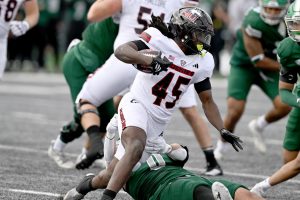DeKalb gets Digital
January 27, 2005
Digital is everywhere.
Digital watches. Digital Video Discs. Digital cameras. Digital libraries. Digital classrooms. Digital dating services. Digital postcards. Digital recording. Digital landmarks on the digital highway of digital life.
There is even a Web site advertising – gasp – digital journalists.
You can’t turn on your high definition television without commercial actors saying how much better they would look with a digital cable feed and how much clearer they would sound in digital audio.
In fact, according to the National Cable & Telecommunications Association, the number of US digital cable users rose from six million in 2000 to 22.9 million in 2004. This increase of over 350 percent now encompasses a third of the nation’s cable customers.
Direct TV, Comcast and Dish Network all utilize standard definition digital transmissions.
The digital uproar has spawned speculation as to the future of cable.
“Eventually, the FCC could switch everything to digital,” said Gilbert Sebenste, staff meteorologist.
The Federal Communication Commission could be on its way.
Last spring, FCC chairman Michael Powell publically cited Berlin successful attempt to become the first major city to shut down all off-air analog TV and mandated a switch to all-digital broadcasting in 2003.
In addition to Europe, Asia is also exploring the idea of going entirely digital. According to a report in the Shanghai Star, Japan implemented a three-part process to eliminate analog TVs by 2008 – the year the Olympic games will be held in Beijing.
Powell, along with Media Bureau chief Kenneth Ferree began exploring options for an American “digital threshold” shortly after Berlin’s drastic transformation.
This threshold would require cable companies to carry digital TV signals in down-converted analog format. Thus, any home already receiving cable would, in theory, be digitally compatible. Powell and Ferree estimated most of the nations top 100 media markets – 85 percent of U.S. households – would meet this threshold.
But what does this mean for NIU?
Chicago, the nation’s third largest television and radio market, falls into the FCC’s supposed digital threshold of the top 100. However, the closest market to DeKalb is Rockford, which ranks 152 and 134 for radio and television respectively.
“Most likely, NIU will implement digital TV slowly,” said George Morisette, chief TV engineer at Media Services, “as the residents here bring in newer TVs with digital tuners and request the service.”
NIU uses its own cable circuit and does not have a contract with a cable company like Comcast.
The 12-channel television system installed in the mid-1970s has undergone many checks and upgrades. Last year a test proved the system could deliver over 200 digital channels to the residents halls.
“Right now, technically the system is ready,” said Sebenste. “Essentially, it’s industry standard because of a recent upgrade.”
However, such an upgrade might not be cost efficient, as all final decisions fall to the Residents Hall Association as well as Student Housing & Dining.
“[Right now] all rooms must have a hook up eight months a year for $5 a month [which is] included in the room rental,” said Morisette. “That’s how the rates are kept low.”
Cable television began in 1948 as an alternative to poor network reception. Since its conception, it has served as quality control. Many experts feel digital cable is the next step in a natural progression.
“[Digital TV] allows for private use for things like wireless internet. As a result, making everything more efficient,” Sebenste said.
The NCTA sites the difference between digital and analogue cable as similar to the difference in quality between CDs and tapes – since compact discs have the audio digitally inscribed and tapes are manually transferred.
Phone calls to Dish Network and Direct TV were not returned, and Comcast sales associates said they knew nothing of an all-out switch to digital – even if the company’s on-hold message rambled on about the advantages of digital TV.






